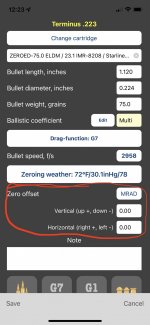I have a new gun and I am experimenting with different ammo. For now I settled on 175 gr hpbt w a .505 bc, moving at 2620fps due to cost, availability and grouping with my rifle.
I Zeroed at 100yd and my come up at 200yd is .5.
When I shoot 168gr by the same manufacturer, moving at 2680fps, w a .462 bc my 200yd come up is 0. In other words at 200yds my turret is 0.
I am going over to the 600yd range next. I have a variety of ammo left over from my experimenting. Sticking with just the 175 and 168 ammo discussed above, how would I get a good TRY number for the 168 ammo at 300,400 etc ?
If you use weaponized math my 200yd number is 0. 0x 2.48= 0.
Even if you used .1 x2.48 you get .248 which doesn’t seem right.
A broader question is if you ran out of ammo and needed to switch to a different ammo, is there a “rule of thumb” you would use to get on target without rezeroing for each ammo?
I Zeroed at 100yd and my come up at 200yd is .5.
When I shoot 168gr by the same manufacturer, moving at 2680fps, w a .462 bc my 200yd come up is 0. In other words at 200yds my turret is 0.
I am going over to the 600yd range next. I have a variety of ammo left over from my experimenting. Sticking with just the 175 and 168 ammo discussed above, how would I get a good TRY number for the 168 ammo at 300,400 etc ?
If you use weaponized math my 200yd number is 0. 0x 2.48= 0.
Even if you used .1 x2.48 you get .248 which doesn’t seem right.
A broader question is if you ran out of ammo and needed to switch to a different ammo, is there a “rule of thumb” you would use to get on target without rezeroing for each ammo?



